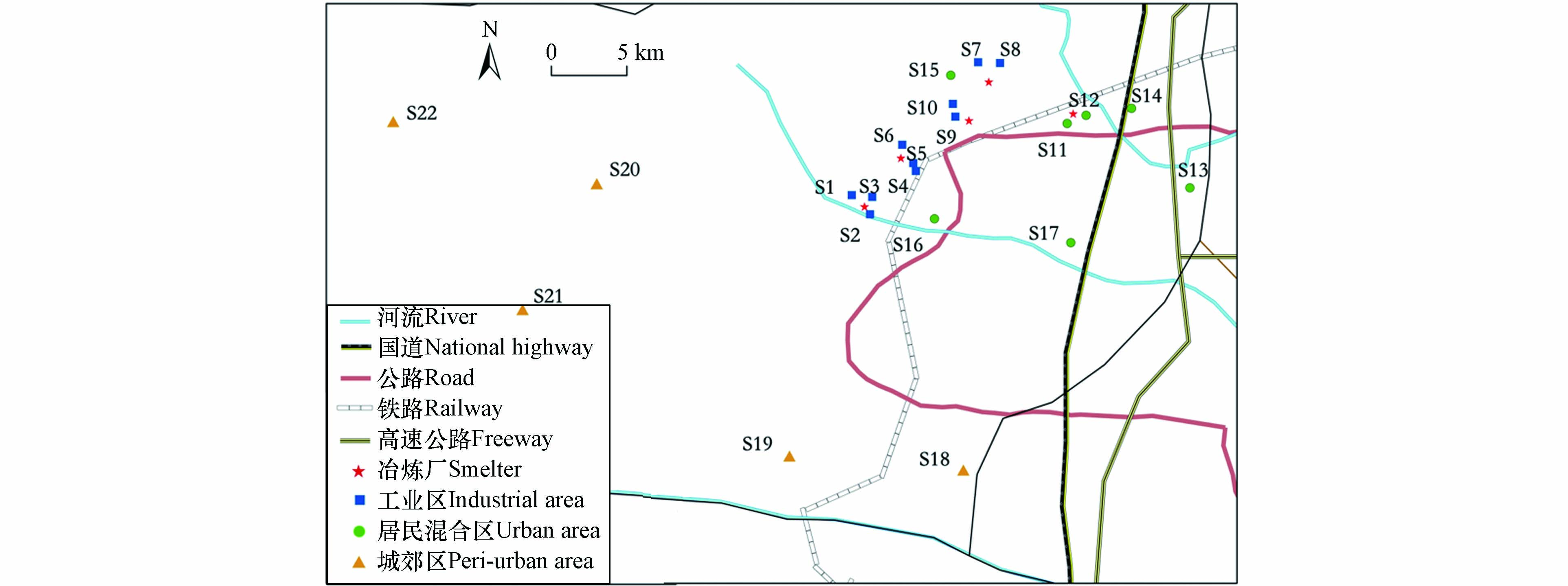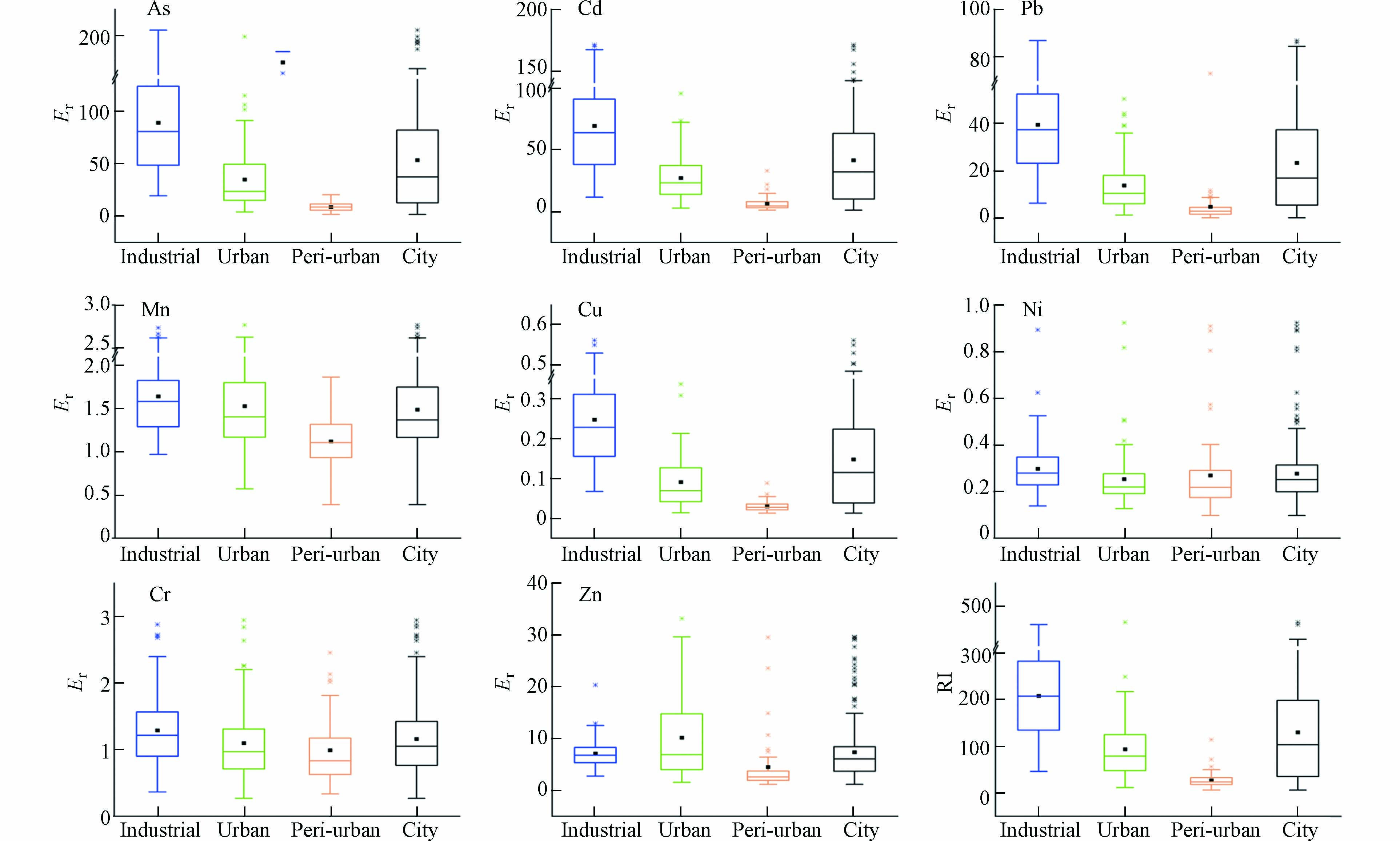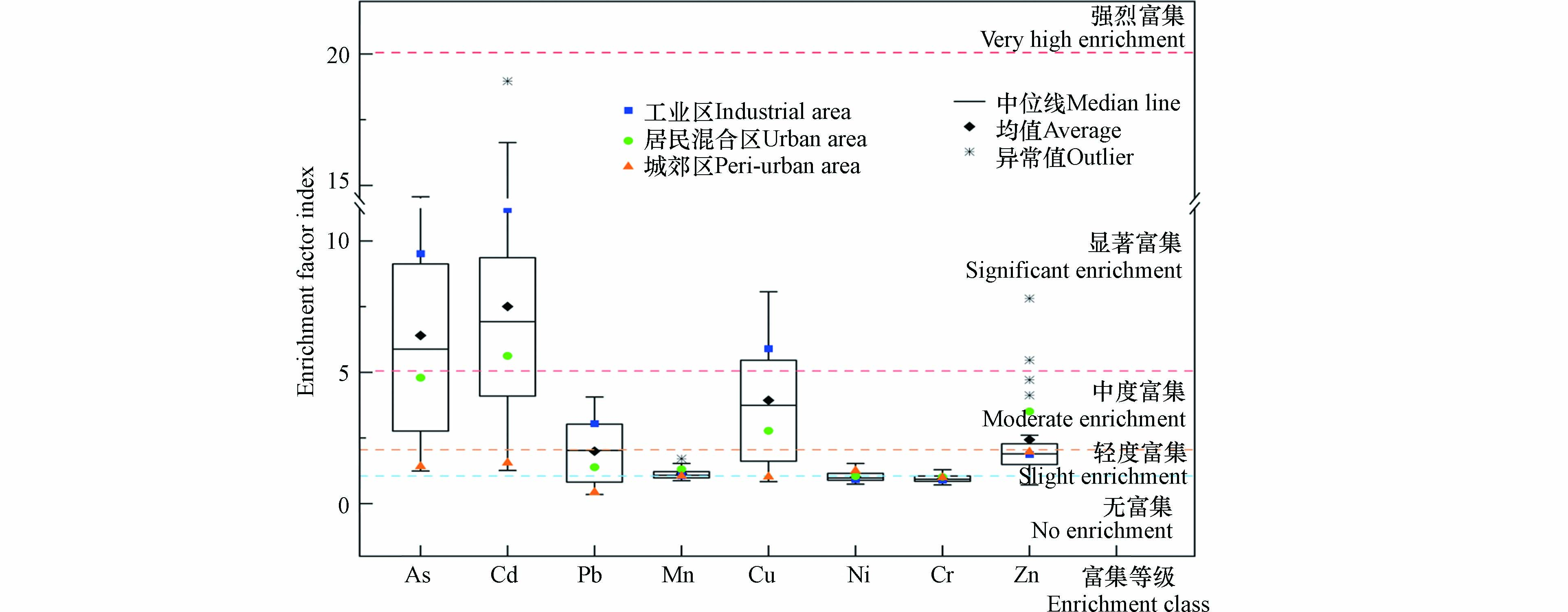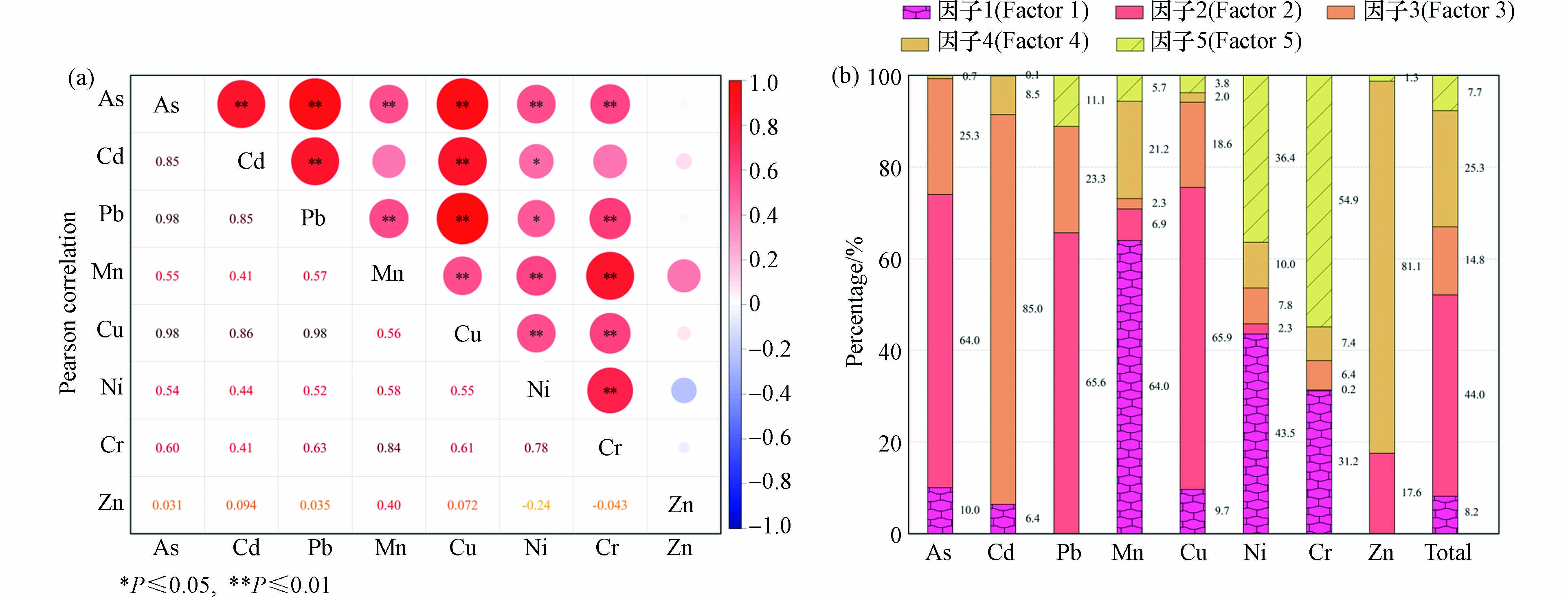-
大气降尘在地表物质交换过程中发挥着重要的媒介作用,同时也是多种污染物的载体和反应床,其中重金属所造成的污染尤为显著[1-2]. 重金属以松散束缚的形式附着在降尘颗粒物表面[3],通过重力或降水进入地表环境中,不仅可以在食物链中传递和累积,还可以通过呼吸、皮肤接触等方式进入人体,对生态环境和人体健康造成严重危害[4-5].
近年来,城市工业、建筑业等快速发展造成的降尘重金属污染引起了国内外学者的广泛关注,故明确重金属污染特征及来源,开展生态及健康风险评价等研究对于城市大气环境防治具有重要意义. 国内外诸多学者研究降尘重金属含量发现,工业及交通污染源使得降尘中重金属Pb、Cd、As、Zn等含量显著增高,均超过了当地的土壤背景值[6-8]. 近几年在重金属污染源解析方面,正定矩阵因子分析模型(PMF)由于具有定性识别污染源并定量解析源贡献率的特点而被广泛应用[6, 9-10],如Chen等[9]利用PMF模型对宜兴蠡河流域降尘重金属进行源解析发现Zn主要来自交通排放,Cr主要来自自然源. 此外,国内外大量研究中采用内梅罗、地累积以及富集因子等多种研究方法进行降尘重金属污染水平评估[7, 11],并采用健康风险评价模型进一步评估其对人体健康的影响,如栾慧君等[12]研究发现,徐州北郊降尘中As对儿童存在一定非致癌和致癌风险;Weerasundara等[7]研究斯里兰卡降尘重金属的健康风险发现,儿童比成人面临更高的健康风险. 然而目前我国对降尘重金属的各项研究主要集中在上海、北京、南京和兰州等大型人口密集城市的主城区[3, 13-14]、城市公园和街道[15-16]及单一污染源周边[17]. 对于具有复杂铅锌冶炼等行业的重工业城市而言,探究更多的是冶炼厂周边土壤重金属污染[18-19],关于其降尘中重金属的污染评价和风险研究仍鲜有报道.
本研究区是河南省某典型铅锌冶炼城市,既有以冶炼和化工为主的重工业集群区,又有人口居住较集中、交通频繁的居民混合区以及以丘陵和山区为主的城郊区[20],故具有区域划分明显、重金属污染来源更多且更复杂的特征. 该研究以全市不同功能区大气降尘为研究对象,分析2021年逐月降尘重金属含量及污染特征,明确区域内降尘重金属污染来源并进行健康风险评估,以期为改善该市及全国铅锌冶炼城市大气重金属污染状况、保护居民身体健康提供科学支撑和借鉴依据.
-
研究区是河南省西北部的某个城市,北依王屋、太行两山,南隔黄河,属暖温带大陆性季风气候,主导风向为东风,年平均温度为14.6 ℃,年平均降雨量为567.9 mm. 该市经济产业以铅锌、钢材冶炼为主,是我国重要的铅锌深加工基地[8].
本次研究综合考虑该城市地形特征和工业分布情况,采用以均匀布点为主,兼顾主导风向和不同功能区差异为辅的方法,共布设了22处采样点(图1),分别为工业区(10处)、居民混合区(7处)和城郊区(5处). 各采样点布置2个降尘缸以进行平行监测,于2021年1月—12月间逐月进行采集. 参考国家标准《环境空气降尘的测定-重量法》(GB/T 15265—1994),采样点设置在降尘缸不易被损坏且易于更换的地方,附近无高大建筑物及局部污染源. 采用降尘缸(直径15 cm,高度30 cm,内壁光滑的聚乙烯塑料桶,加入60 mL乙二醇溶液)收集干湿降尘,放置高度应距离地面5—12 m,夏季多雨天气及时更换缸体防止液体溢出,采样时将降尘收集液转移至塑封袋进行密封保存. 样品寄回实验室后借助镊子、尼龙筛剔除树叶、昆虫等异物,并用蒸馏水冲刷塑封袋及异物上残留降尘,将收集液蒸干并研磨后得到降尘样品,装入密封袋保存.
-
降尘中重金属全量采用硝酸-王水法(硝酸∶盐酸=1∶3)消解. 称取制备好的样品0.1000 g于聚四氟乙烯消解管中,加入 6 mL浓盐酸(GR)和2 mL浓硝酸(GR)后置于电热板消解仪中消解,消解温度控制在150 ℃. 消解后的溶液用 3% 稀硝酸定容至 25 mL容量瓶,经 0.45 μm水系滤头过滤后采用电感耦合等离子发射光谱仪(ICP-OES,Agilent 5110)测定消解液中重金属 Al、As、Cd、Pb、Mn、Cu、Ni、Cr和Zn 全量. 在分析过程中进行空白实验和平行测定,并使用国家标准土样GBW07427(GSS-13) 作为质量监控进行测定,误差范围在85%—107%. 数据结果通过Excel 2016 和 SPSS 26.0软件进行处理,利用Origin 2021和 SigmaPlot 14.0进行绘图分析.
-
地积累指数法(Geo-accumulation index)定量地评价了土壤、沉积物和大气降尘中重金属的污染程度,它综合考虑了自然岩层运动引起的土壤背景值变化和人为因素造成的影响[7]. 其计算公式如下:
式中,Ci为大气降尘中重金属元素的实测含量,mg·kg−1;Bi为元素的土壤环境背景值,mg·kg−1;k为考虑背景值波动而设定的修正系数,取k=1.5. 重金属污染程度共分为7个等级,见表1.
-
潜在生态风险指数法[21]是1980年由Hakanson结合重金属化学性质和生态环境毒理效应提出的衡量重金属对生态潜在风险的评价方法. 计算公式如下[22]:
式中,
${E}_{\mathrm{r}}^{i} $ 和RI分别为单个元素i的潜在风险指数和多种元素的综合潜在风险指数,其环境质量评价分级见表2;${T}_{\mathrm{r}}^{i} $ 为元素i的毒响应系数(As、Cd、Pb、Mn、Cu、Ni、Cr和Zn的${T}_{\mathrm{r}}^{i} $ 取值依次为10、30、5、1、5、5、2和1);Ci为样品中元素i的实测含量;Si为元素i的标准参考值. -
富集因子法(enrichment factor, EF)是在对元素归一化处理的基础上,用于定量评价降尘重金属的污染富集程度,并初步判断重金属污染来源的常用分析方法. 其计算公式如下[23]:
式中,Ci和Cr分别为降尘样品中元素i和参比元素r的实测含量,mg·kg−1;Bi和Br分别为背景值中测量元素i和参比元素r的含量,mg·kg−1;本研究中参比元素选择Al. 富集因子指数共划分为6个等级:EF ≤ 1,无富集;1 < EF ≤ 2,轻度富集;2 < EF ≤ 5,中度富集;5 < EF ≤ 20,显著富集;20 < EF ≤ 40,强烈富集;40 < EF,极强富集;一般认为,EF越接近1,可认为该元素主要来源于自然源,若EF>10,则主要来源于人为源.
-
正定矩阵因子分析法(PMF)将样本重金属含量矩阵Xij分解成源贡献矩阵Gik和源成分矩阵Fkj,并综合数据间误差增加残差矩阵Eij,根据求解矩阵结果定量识别各污染源及贡献率,具体方程如下[24]:
通过最小二乘法经多次迭代运算得到最小化的目标函数Q,从而得到最优因子矩阵和源剖面:
式中,Uij为第i个样品中第j个元素的不确定度.
-
附着在大气颗粒物上的重金属主要通过手-口摄食、呼吸吸入和皮肤接触等3种途径进入人体. 本研究采用美国环境保护署(US EPA)开发的健康风险评价模型,来计算这3种途径下潜在有毒重金属的日均暴露剂量并进行健康风险评价(非致癌风险和致癌风险),计算公式如下[25]:
式中,ADDing、ADDinh和ADDdermal分别表示从手-口、呼吸吸入和皮肤接触3种途径的日均重金属摄入量,mg·(kg·d)−1;公式中其余参数的含义和取值见表3.
-
依据模型及国家癌症研究机构(LARC)研究结果[29],重金属As、Cd、Pb、Mn、Cu、Ni、Cr和Zn均具有慢性非致癌风险,其中As、Cd、Ni和Cr具有致癌风险. 由于EPA只提供了经呼吸途径致癌暴露量参考值,故只考虑致癌重金属经呼吸途径的致癌风险. 计算公式如下[25]:
式中,HQi代表某种重金属的非致癌风险值,HI代表单项重金属所有暴露途径下的非致癌风险值,CR为致癌重金属在呼吸暴露途径下的致癌风险值,TCR为所有致癌重金属的总致癌风险值. RfDi为某种重金属摄入的参考剂量,SFinh为致癌斜率因子,RfDi和SFinh取值见表4.
当HQi或HI<1时表示非致癌风险较小,可以忽略;当HQi或HI≥1时表示有非致癌风险,值越大风险越大. 当CR或TCR<10−6时表示致癌风险较小,可以忽略;当CR或TCR介于10−6—10−4时,致癌风险在可接受范围内;当CR或TCR≥10−4时,表示有致癌风险.
-
2021年全市不同功能区降尘重金属含量统计结果见表5. 降尘中As、Cd、Pb、Mn、Cu、Ni、Cr和Zn的平均含量分别是河南省土壤背景值的32.55、1385.78、171.46、1.49、26.62、1.99、1.83、35.31倍. 其中As、Cd、Pb、Cu和Zn元素含量也远高于国家土壤环境质量风险筛选值[30],说明这5种元素污染较严重,这与Xing等[20]研究结果相一致. 元素变异系数反映了其受人为干扰程度和空间离散程度[16, 23]. 由表5可知,城郊区相对于其他功能区而言,各重金属含量均最低,污染相对较轻. 工业区中降尘重金属含量明显高于其他功能区(除Zn外),其中As、Cd、Pb和Cu的含量远高于其他功能区2.55—10.99倍,变异系数也均在75%以上,说明这4种元素受人为污染的程度很大,分布更为离散. Zn含量在居民混合区最高,其变异系数为34.44%,分布较离散. Mn、Ni和Cr含量在各功能区差别不大,变异系数低.
为进一步探究该市不同功能区降尘重金属在全国范围内的污染水平,选择东南部、西南、西北和东北等不同地区的城市进行比较(表6). 可以看出,该市降尘中大部分重金属含量高于全国工业区和非工业区的平均含量. 与各城市工业区相比,降尘中Cd、Pb和Cu含量远高于其他城市,其中Pb仅低于天津,稍高于同样以铅锌冶炼为主的宝鸡;Cu仅低于“锡之都”个旧,略高于厦门、南丹和有“钢铁摇篮”之称的黄石;Mn略高于其他城市;Zn含量在各城市工业区中处于中低水平. 与各城市非工业区相比,Cd和Pb含量均高于其他城市,说明重工业对于非工业区大气环境中Cd和Pb含量有显著影响;Cu含量处于较低水平,仅略高于西北城市宝鸡和兰州,且低于全国非工业区平均含量;Zn含量低于黄石和厦门. As、Ni和Cr在各功能区总体与全国平均水平保持相当. 由此可得,该市在全国污染水平偏高,各功能区均以Cd和Pb污染最严重,可能与其主要进行铅、锌和钢的生产有关,而其他元素与各地域城市相比整体处于中等偏下污染水平.
-
不同功能区降尘重金属的地累积指数结果如图2所示. 全市各重金属Igeo均值以Cd最高(9.17),其次为Pb(6.39),二者均为极度污染;Zn(4.50)属于重度污染;Cu(3.75)和As(3.72)属于偏重度污染;Cr(0.59)属于轻度污染;Mn(−0.03)和Ni(-0.87)属于无污染.
总体上各功能区Igeo均值排序为工业区>居民混合区>城郊区. 对于重金属Cd,所有功能区Cd的地累积指数均最大,且都大于5,处于极度污染水平,说明该市涉重企业长期生产所造成Cd污染的严重性和普遍性. 对于重金属Pb,工业区(7.51)>居民混合区(6.16)>城郊区(4.69),其中72.73%采样点属于极度污染,22.73%属于重度污染. 而重金属Zn,居民混合区(4.99)>工业区(4.56)>城郊区(3.69),其中18.18%采样点属于极度污染,54.55%属于重度污染,27.27%属于偏重度污染. 对于重金属Cu和As,均为工业区(Cu:4.89;As:4.91)>居民混合区(Cu:3.54;As:3.55)>城郊区(Cu:1.99;As:1.81). Cu和As只有部分采样点为极度污染,其比例均为18.18%. 对于重金属Mn、Ni和Cr,污染程度较小,属于无污染-轻度污染占比分别为100%、100%和90.91%. 综上,As、Cd、Pb、Cu和Zn为主要污染物,对大气重金属污染贡献程度较高,考虑与当地铅锌冶炼工业有关.
-
为进一步了解降尘重金属污染对生态的潜在风险,对上述8种重金属进行潜在生态风险评价,结果如图3所示.
从单因子生态风险指数来看,全市各重金属Er的具体排序为:As(53.41)>Cd(41.45)>Pb(23.36)>Zn(7.38)>Mn(1.49)>Cr(1.16)>Ni(0.28)>Cu(0.15),以As和Cd的生态风险最大,均为中度危害,其余均为轻微危害;总体上除重金属Ni和Zn外,各重金属在不同功能区的指数均值大小为:工业区>居民混合区>城郊区,而Zn在居民混合区的指数均值明显高于其他功能区,这与地累积指数分析结果相一致,说明Zn除了受工业污染影响外,居民区的交通污染源对其有一定影响. 该市综合生态风险指数RI高达129.74,为中等危害,其中轻微、中等和较强危害的样点数占比分别为62.99%、25.20%和11.81%.
-
图4是8种重金属的富集因子指数结果. 其中Mn、Ni和Cr元素EF均值分别为1.12、0.99和0.94,均接近1,说明主要来源于自然源;Pb(2.10)、Zn(2.19)和Cu(4.08)均为中度富集,受一定人为污染影响;As(6.62)和Cd(7.71)均为显著富集,说明主要来自人为源. Zn在居民混合区富集程度最高,而As、Cd、Pb和Cu在工业区富集程度更高,说明Zn与其他元素同源的可能性较小. 而Mn、Ni和Cr在各功能区富集程度相近,说明受人为干扰程度小. As、Cd、Pb、Cu和Zn与金属冶炼、燃煤和交通排放等相关 [9, 22],故该市主要人为污染包括冶金工业和机动车尾气排放等.
-
为进一步了解各元素间的相关性并定量解析污染来源,本研究结合相关性分析和PMF模型进行源解析,结果如图5所示. 具有显著相关性的重金属元素之间来源相同的可能性较大或是复合污染[43-44],同时设置3—6个因子运行PMF模型时,发现当因子数为5时Qrobust/Qtrue处于快速下降且大部分残差在−3—3之间,故最终解析出5种污染源.
因子1中Mn、Ni和Cr载荷较高,具有一定相关性且富集因子接近1,主要来源于土壤母质[40],故可认为是自然源. 因子2中载荷较高的是As、Pb和Cu,三者在P<0.01下相关性系数均为0.98,呈极显著相关,且在工业区中富集程度显著,故可认为因子2主要为冶金工业源. 因子3中载荷较高元素为Cd、其次为As,两者元素在P<0.01下呈显著相关(r=0.85),且Cd和As通常被认为是市政焚烧和燃煤的标志元素[9],故将因子3定义为焚烧及燃煤源. 因子4主要载荷元素为Zn,与其他元素间无明显相关性,同时Zn元素主要富集在道路交通密集、车辆运输活动频繁的居民混合区,通常是轮胎磨损和汽车制动等交通排放的指数元素[1, 6],所以因子4解释为交通污染源. 因子5中Ni和Cr载荷最高,而这两种元素除来自自然源外,还是二次扬尘的标志元素[45],故因子5可解释为二次扬尘源. 其中以冶金工业源和交通污染源占比最高,贡献率分别高达44.0%和25.3%,对这两种污染源需重点关注,其次分别为焚烧及燃煤源(14.8%)、自然源(8.2%)和二次扬尘源(7.7%).
-
根据公式,计算得到不同功能区降尘重金属经3种暴露途径下对不同人群的非致癌风险商(HQ)和总非致癌风险指数(HI),结果如表7—8所示.
从表7可知,不同功能区不同暴露途径下重金属非致癌风险商(HQ)排序均为:手-口摄食途径>皮肤接触途径>呼吸吸入途径,说明手-口摄食途径是降尘重金属非致癌风险主要的暴露途径,经呼吸吸入途径影响风险最小;且各重金属经不同暴露途径下的非致癌风险均呈现儿童>成年女性>成年男性的特征,这与其他多数地区研究中所得结论保持一致[2, 7, 12, 39, 44]. 对于不同人群,重金属经手-口摄食途径下,在各功能区中非致癌风险商(HQ)较大的元素为As和Pb,其次为Cr;经皮肤接触途径下,在工业区和居民混合区非致癌风险(HQ)贡献较高元素为Cd和Pb,在城郊区是Cr;经呼吸吸入途径下,各功能区非致癌风险商(HQ)最大元素均为Mn. 8种重金属中,As和Pb的单项非致癌风险显著且对儿童的风险更大. 根据表8,各重金属对于不同人群在该研究区域内总的非致癌风险指数(HI)顺序为:工业区Pb>As>Cd>Cr>Mn>Cu>Zn>Ni(成年男和成年女),Pb>As>Cd>Cr>Cu>Mn>Zn>Ni(儿童);居民混合区As>Pb>Cd>Cr>Mn>Zn>Cu>Ni;城郊区Pb>As>Cr>Mn>Cd>Zn>Cu>Ni. 可以看出,总非致癌风险指数(HI)最高的元素是As和Pb,在各功能区中均大于1,对儿童存在更大程度的非致癌健康风险(As:1.93—20.62;Pb:2.54—20.75);其次是Cd,仅在工业区中会对儿童产生非致癌风险(HI:1.94),所以对于这3种元素仍需加强污染排放管控力度,不断优化产业结构及污染物处理技术,以期进一步减少排放. 对比其他地区研究可发现,很多重工业城市以及金属冶炼厂区附近都普遍存在As、Cd、Pb等重金属的非致癌风险,若长期暴露在此环境中,易造成神经系统及内分泌系统等多方面疾病,例如血铅含量增高等[2-3, 38, 46]. 其他重金属元素虽然总非致癌风险指数(HI)在各功能区中均未超过1,非致癌风险较小,但类似于Cr亦是造成健康风险的主要污染物,故也应长期重视,加强防范.
该市不同功能区4种致癌重金属经呼吸途径对不同人群的暴露致癌风险计算结果如表9所示. 致癌重金属对不同群体的致癌风险排序均为:As>Cr>Cd>Ni(工业区),Cr>As>Cd>Ni(居民混合区和城郊区),且致癌风险也都为CR(成年男性)>CR(成年女性)>CR(儿童). 总体而言,各功能区降尘中重金属As、Cd、Ni和Cr单项致癌风险均在10−7—10−9之间,总致癌风险TCR值也均在风险阈值10−6—10−4范围内,故可认为在该市内经呼吸摄入的降尘重金属对人体尚不存在致癌风险. 国内外多数研究也普遍认为As、Cd、Ni和Cr经呼吸途径的致癌风险是在可接受范围内的[3, 12, 33, 36, 46].
-
(1)降尘中重金属As、Cd、Pb、Mn、Cu、Ni、Cr和Zn的平均含量分别是河南省土壤背景值的32.55、1385.78、171.46、1.49、26.62、1.99、1.83和35.31倍. 其中As、Cd、Pb、Cu和Zn的变异系数大,在各功能区间分布不均匀,受人为污染严重. 此外,该市在全国污染水平偏高,以Cd和Pb污染最突出,考虑与当地铅锌冶炼生产有关.
(2)地累积指数法结果表明,As、Cd、Pb、Cu和Zn污染程度较高,其中Cd的污染最严重,所有采样点均为极度污染. 潜在生态风险评价表明,As和Cd的生态风险最大,其余均为轻微危害.
(3)富集因子法、相关性分析以及PMF模型综合源解析结果表明:该市降尘重金属共有5种来源,主要来自金属冶炼等工业污染源和交通污染源,部分来源于焚烧及燃煤源、自然源和二次扬尘源,贡献率分别为44.0%、25.3%、14.8%、8.2和7.7%. 故需要重点管控相关涉重行业及交通污染排放情况,以减轻城市重金属污染.
(4)该市降尘重金属中以As和Pb对人体造成的非致癌健康风险最大,其次为Cd,其他金属元素基本不会对人体造成健康风险. 其中手-口摄食途径是降尘重金属非致癌风险的最主要暴露途径,对儿童的非致癌风险远大于成年人. 各功能区重金属经呼吸途径的总致癌风险均在风险阈值内,不具有致癌风险.
某典型铅锌冶炼城市降尘重金属污染特征及健康风险评价
Pollution characteristics and health risk assessment of heavy metals in atmospheric deposition in a typical lead-zinc smelting city
-
摘要: 为探究典型铅锌冶炼城市大气降尘重金属的污染特征和健康风险,于2021年逐月采集河南省某市不同功能区共22个点位511份有效降尘样品,测定了样品中重金属含量,通过地累积指数法和生态风险评价评估了重金属污染水平,结合富集因子法、相关性分析和正定矩阵因子分析法(PMF)明确了重金属污染来源,并利用健康风险评价模型评估了重金属暴露健康风险. 结果表明,全市降尘中As、Cd、Pb、Mn、Cu、Ni、Cr和Zn的平均含量均高于河南省土壤背景值,其中As、Cd、Pb、Cu和Zn的变异系数大,在各功能区分布不均匀. 地累积指数法结果显示As、Cd、Pb、Cu和Zn污染程度较高,均为偏重度污染及以上;潜在生态风险评价结果表明As和Cd存在中度生态危害风险. 富集因子分析结果为Cd(7.71)>As(6.62)>Cu(4.08)>Zn(2.19)>Pb(2.10)>Mn(1.12)>Ni(0.99)>Cr(0.94),表明除Mn、Ni和Cr外均受不同程度人为污染,并综合相关性分析和PMF模型定量解析出冶金工业源(44.0%)、交通污染源(25.3%)、燃煤及焚烧源(14.8%)、自然源(8.2%)和二次扬尘源(7.7%)这5种重金属来源. 健康风险评价表明非致癌风险最主要暴露途径是手-口摄食,对儿童非致癌风险远高于成年男性和女性,各功能区降尘重金属经呼吸途径总致癌风险值均低于10−6,不具有致癌风险.Abstract: To explore the characteristics and health risks of heavy metals in atmospheric deposition in a typical lead-zinc smelting city, 511 effective atmospheric deposition samples from 22 sites in different functional areas of a city in Henan Province were collected monthly in 2021. Geo-accumulation index and potential ecological risk assessment methods were used to assess the heavy metal pollution level by determining the concentration of collected samples. Subsequently the sources of heavy metal pollution were specified by the combination of enrichment factor method, correlation analysis and positive matrix factor analysis (PMF). Additionally, the evaluation of exposure to heavy metals and health risks were built through health risk assessment model. Results showed that the average concentrations of As, Cd, Pb, Mn, Cu, Ni, Cr and Zn in atmospheric deposition samples were higher than the soil background values of Henan Province. Among them, the distribution of As, Cd, Pb, Cu and Zn was uneven due to their high variation coefficients. Besides, the result of Geo-accumulation index showed that these areas were highly polluted by As, Cd, Pb, Cu and Zn, which indicated that these elements belonged to heavy or heavier pollution level. However, the potential ecological risk assessment results indicated that the potential risk of As and Cd was moderate. The enrichment factor of each heavy metal followed the order of Cd(7.71) > As(6.62) > Cu(4.08) > Zn(2.19) > Pb(2.10) > Mn(1.12) > Ni(0.99) > Cr(0.94), which indicated that all heavy metals were affected by artificial behaviors except for Mn, Ni and Cr. Based on the correlation analysis and PMF model, it could be identified that the pollution came from metallurgical industry source(44.0%), traffic pollution source(25.3%), incineration and coal combustion source(14.8%), natural source(8.2%) and secondary dust source(7.7%), respectively. The health risk assessment indicated that the main exposure route of non-carcinogenic risk was hand-mouth intake, and the non-carcinogenic risks for children were higher than those for adult female and male. The total carcinogenic risk values of heavy metals through respiratory were lower than 10−6, indicating that there was no carcinogenic risk.
-
Key words:
- atmospheric deposition /
- heavy metal /
- pollution characteristics /
- source analysis /
- health risk /
- lead-zinc smelting.
-

-
表 1 地累积指数法的污染分级表
Table 1. Classification criteria of Geo-accumulation Index
等级
Classes地累积指数(Igeo)
Geo-accumulation index污染程度
Pollution degree0 Igeo≤0 无污染 1 0<Igeo≤1 轻度污染 2 1<Igeo≤2 偏中度污染 3 2<Igeo≤3 中度污染 4 3<Igeo≤4 偏重度污染 5 4<Igeo≤5 重度污染 6 5<Igeo 极度污染 表 2 潜在生态风险评价分级
Table 2. Classification of potential ecological risk assessment
${E}_{\mathrm{r}}^{i} $ RI 生态风险评价
Ecological risk assessment<30 <70 轻微危害 30 — 60 70 — 140 中等危害 60 — 120 140 — 280 较强危害 120 — 240 280 — 560 很强危害 ≥240 ≥560 极强危害 表 3 重金属日均暴露量模型参数含义及取值
Table 3. Parameters and values for average daily exposure dose model of heavy metals
参数
Parameters含义
Definitions单位
Units取值Values 参考文献
References成年男性Male 成年女性Female 儿童Children C 重金属浓度 mg·kg−1 本研究 IngR 摄食降尘速率 mg·d−1 100 100 200 [26] InhR 呼吸速率 m3·d−1 18.1 14.6 7.63 [25] CF 单位转换 kg·mg−1 1×10−6 1×10−6 1×10−6 [26] EF 暴露频率 d·a−1 350 350 320 [27] ED 暴露年限 a 24 24 6 [26] BW 平均体重 kg 67.3 57.7 15.9 [25] AT 平均暴露时间 d 365×ED(非致癌) [28] 365×70 (致癌) PEF 颗粒物排放因子 m3·kg−1 1.36×109 1.36×109 1.36×109 [27] SA 暴露皮肤面积 cm2 2145 2145 1150 [27] AF 皮肤黏着度 mg·cm−2 0.07 0.07 0.2 [25] ABF 皮肤吸收因子 无量纲 0.001 0.001 0.001 [25] 表 4 重金属的参考剂量和致癌斜率因子[13]
Table 4. Reference doses and carcinogenic slope factors of heavy metals
项目
Items单位
UnitsAs Cd Pb Mn Cu Ni Cr Zn RfDing mg·(kg·d)−1 3.00×10−4 1.00×10−3 3.50×10−3 4.60×10−2 4.00×10−2 2.00×10−2 3.00×10−3 0.30 RfDinh mg·(kg·d)−1 3.00×10−4 1.00×10−3 3.52×10−3 1.43×10−5 4.02×10−2 2.06×10−2 2.86×10−5 0.30 RfDdermal mg·(kg·d)−1 1.23×10−4 1.00×10−5 5.25×10−4 1.84×10−3 1.20×10−2 5.40×10−3 6.00×10−5 0.06 SFinh (kg·d)·mg−1 15.10 6.30 0.84 42.00 表 5 不同功能区降尘重金属含量统计结果(mg·kg−1)
Table 5. Statistics of heavy metal concentrations of atmospheric deposition in different functional areas(mg·kg−1)
重金属种类
Types of
heavy
metals平均值Average 变化范围
Variation
range变异
系数/%
Variation
coefficient土壤环境
风险筛查值
Soil environmental
risk screening
values河南省土壤
背景值[31]
Soil background values of Henan Province第二类用地
筛选值[32]
Screening
values for
type Ⅱ Land工业区
Industrial
area居民混合区
Residential
area城郊区
Suburban
area全市
City
areaAs 533.61 209.15 52.40 320.44 10.56—1230.84 76.59 25.00 9.80 60.00 Cd 149.77 58.65 13.63 89.80 2.63—368.13 77.23 0.60 0.064 65.00 Pb 6288.38 2222.38 799.66 3738.04 55.44—13903.51 76.20 170.00 21.80 800.00 Mn 919.01 854.76 626.27 833.16 218.00—1550.47 18.47 — 560.00 560.001) Cu 891.27 326.76 108.03 532.45 46.63—2021.24 75.90 100.00 20.00 18000.00 Ni 53.57 45.64 48.43 49.88 17.63—166.27 8.07 190.00 27.30 900.00 Cr 161.26 137.38 124.06 145.34 33.90—368.17 12.97 250.00 63.30 250.002) Zn 2180.66 2875.29 1357.09 2206.62 356.39—8891.05 34.44 300.00 62.50 300.002) Al3) 18023.66 13705.52 12595.17 15435.17 2595.42—27677.60 18.23 — — — 注:“—”表示无数据;1)表示选用河南省土壤背景值;2)表示选用土壤环境风险筛查值;3)参比元素不作讨论.
Note: “—” indicates no data, 1) indicates that Henan soil background value was selected, 2) indicates that environmental risk screening values was selected, 3) indicates reference element was not discussed.表 6 全国部分城市不同功能区降尘重金属含量对比(mg·kg−1)
Table 6. Comparison of heavy metals concentrations in atmospheric deposition from different functional areas of other cities (mg·kg−1)
城市
Cities地域
Regions类型
TypesAs Cd Pb Mn Cu Ni Cr Zn 参考文献
References河南省某市 华中 工业混合区 371.38 104.21 4255.38 886.885 609.015 49.605 149.32 2527.975 本研究 非工业区 52.40 13.63 799.66 626.27 108.03 52.38 141.56 1357.09 黄石 华中 工业区 — — 296.84 839.01 555.84 — 652.64 15343.27 [33] 非工业区 — — 391.32 799.60 696.09 — 391.09 3659.07 厦门 华东 工业区 — — 205.00 811.00 621.00 52.58 248.00 4245.00 [34] 非工业区 — — 135.00 785.33 365.50 34.14 145.50 4778.50 天津 华北 工业区 — — 4696.15 — 226.58 44.32 64.54 5846.24 [35] 非工业区 27.38 1.73 82.50 397.65 201.08 37.05 — 736.43 [36] 宝鸡 西北 工业区 — 65.50 2630.5 — 131.10 21.70 79.50 4449.30 [17] 非工业区 — 4.21 223.20 — 65.80 64.50 60.80 343.80 [37] 葫芦岛 东北 工业区 — 72.84 533.20 — 264.40 — — 5271.01 [38] 南丹 华南 工业区 3912. 08 58.67 981.40 — 521.36 — — 4252.10 [39] 个旧 西南 工业区 — 37.13 670.61 — 2531.00 55.01 165.26 4650.85 [40] 北京 华北 非工业区 — 4.00 154.80 — 158.90 46.85 134.30 741.25 [41] 南京 华东 非工业区 17.30 1.92 119.00 602.00 141.00 115.00 133.00 585.00 [15] 兰州 西北 非工业区 — 4.40 129.75 499.01 83.07 38.97 84.76 367.02 [3] 全国工业区 369.39 22.02 861.72 — 332.67 50.10 206.97 2319.00 [42] 全国非工业区 38.16 3.31 170.97 — 116.12 42.51 132.82 603.60 表 7 不同功能区不同暴露途径降尘重金属非致癌风险(HQ)
Table 7. Non-carcinogenic risk (HQ) of heavy metals to human health under various exposure approaches in atmospheric deposition from different functional areas
功能区
Areas元素
Elements成年男Male 成年女Female 儿童Children HQing HQinh HQdermal HQing HQinh HQdermal HQing HQinh HQdermal 工业区
Industrial
areaAs 2.66 3.54×10−4 9.73×10−3 3.10 3.33×10−4 1.13×10−2 20.6 5.77×10−4 5.77×10−2 Cd 2.25×10−1 2.99×10−5 3.38×10−2 3.02×10−1 2.82×10−5 3.94×10−2 1.74 4.88×10−5 2.00×10−1 Pb 2.66 3.52×10−4 2.66×10−2 3.10 3.31×10−4 3.11×10−2 20.59 5.74×10−4 1.58×10−1 Mn 2.87×10−2 1.23×10−2 1.08×10−3 3.35×10−2 1.16×10−2 1.26×10−3 2.22×10−1 2.01×10−2 6.39×10−3 Cu 3.30×10−2 4.37×10−6 1.65×10−4 3.85×10−2 4.11×10−6 1.93×10−4 2.55×10−1 7.13×10−6 9.79×10−4 Ni 4.15×10−3 5.36×10−7 2.31×10−5 4.84×10−3 5.05×10−7 2.69×10−5 3.21×10−2 8.75×10−7 1.37×10−4 Cr 8.05×10−2 1.12×10−3 6.05×10−3 9.39×10−2 1.06×10−3 7.05×10−3 6.23×10−1 1.83×10−3 3.58×10−2 Zn 1.01×10−2 1.35×10−6 7.61×10−5 1.18×10−2 1.27×10−6 8.87×10−5 7.84×10−2 2.20×10−6 4.51×10−4 居民
混合区
Residential
areaAs 9.93×10−1 1.32×10−4 3.64×10−3 1.16 1.24×10−4 4.24×10−3 7.69 2.16×10−4 2.16×10−2 Cd 8.99×10−2 1.20×10−5 1.35×10−2 1.21×10−1 1.13×10−5 1.57×10−2 6.96×10−1 1.95×10−5 8.00×10−2 Pb 9.05×10−1 1.20×10−4 9.06×10−3 1.06 1.13×10−4 1.06×10−2 7.00 1.95×10−4 5.37×10−2 Mn 2.72×10−2 1.16×10−2 1.02×10−3 3.17×10−2 1.10×10−2 1.19×10−3 2.10×10−1 1.90×10−2 6.05×10−3 Cu 1.16×10−2 1.54×10−6 5.83×10−5 1.36×10−2 1.45×10−6 6.79×10−5 9.01×10−2 2.51×10−6 3.45×10−4 Ni 3.74×10−3 4.83×10−7 2.08×10−5 4.36×10−3 4.54×10−7 2.42×10−5 2.89×10−2 7.88×10−7 1.23×10−4 Cr 6.52×10−2 9.11×10−4 4.90×10−3 7.61×10−2 8.57×10−4 5.71×10−3 5.05×10−1 1.49×10−3 2.90×10−2 Zn 1.76×10−2 2.34×10−6 1.32×10−4 2.05×10−2 2.20×10−6 1.54×10−4 1.36×10−1 3.82×10−6 7.82×10−4 城郊区
Suburban
areaAs 2.49×10−1 3.31×10−5 9.11×10−4 2.90×10−1 3.12×10−5 1.06×10−3 1.93 5.40×10−5 5.40×10−3 Cd 1.94×10−2 2.58×10−6 2.92×10−3 2.61×10−2 2.43×10−6 3.40×10−3 1.50×10−1 4.22×10−6 1.73×10−2 Pb 3.26×10−1 4.31×10−5 3.26×10−3 3.80×10−1 4.05×10−5 3.80×10−3 2.52 7.03×10−5 1.93×10−2 Mn 1.94×10−2 8.30×10−3 7.28×10−4 2.26×10−2 7.81×10−3 8.49×10−4 1.50×10−1 1.35×10−2 4.32×10−3 Cu 3.85×10−3 5.10×10−7 1.93×10−5 4.49×10−3 4.79×10−7 2.25×10−5 2.98×10−2 8.31×10−7 1.14×10−4 Ni 3.73×10−3 4.82×10−7 2.08×10−5 4.35×10−3 4.54×10−7 2.42×10−5 2.89×10−2 7.87×10−7 1.23×10−4 Cr 6.72×10−2 9.39×10−4 5.05×10−3 7.84×10−2 8.83×10−4 5.89×10−3 5.20×10−1 1.53×10−3 2.99×10−2 Zn 6.45×10−3 8.58×10−7 4.84×10−5 7.52×10−3 8.07×10−7 5.64×10−5 4.99×10−2 1.40×10−6 2.87×10−4 表 8 不同功能区降尘重金属非致癌风险指数(HI)
Table 8. Non-carcinogenic health risks of heavy metals in atmospheric deposition from different functional areas
元素
Elements工业区Industrial area 居民混合区Residential area 城郊区Suburban area 成年男
Male成年女
Female儿童
Children成年男
Male成年女
Female儿童
Children成年男
Male成年女
Female儿童
ChildrenAs 2.67 3.11 20.62 9.97×10−1 1.16 7.71 2.50×10−1 2.91×10−1 1.93 Cd 2.59×10−1 3.41×10−1 1.94 1.03×10−1 1.36×10−1 7.76×10−1 2.23×10−2 2.95×10−2 1.68×10−1 Pb 2.69 3.13 20.75 9.14×10−1 1.07 7.06 3.29×10−1 3.84×10−1 2.54 Mn 4.21×10−2 4.63×10−2 2.49×10−1 3.99×10−2 4.39×10−2 2.36×10−1 2.84×10−2 3.13×10−2 1.68×10−1 Cu 3.32×10−2 3.87×10−2 2.56×10−1 1.17×10−2 1.36×10−2 9.04×10−2 3.87×10−3 4.51×10−3 2.99×10−2 Ni 4.18×10−3 4.87×10−3 3.23×10−2 3.76×10−3 4.38×10−3 2.91×10−2 3.75×10−3 4.38×10−3 2.90×10−2 Cr 8.77×10−2 1.02×10−1 6.61×10−1 7.11×10−2 8.27×10−2 5.36×10−1 7.32×10−2 8.52×10−2 5.52×10−1 Zn 1.02×10−2 1.19×10−2 7.89×10−2 1.77×10−2 2.07×10−2 1.37×10−1 6.49×10−3 7.57×10−3 5.02×10−2 表 9 不同功能区降尘重金属致癌风险指数
Table 9. Carcinogenic health risks of heavy metals in atmospheric deposition from different functional areas
元素
Elements工业区Industrial area 居民混合区Residential area 城郊区Suburban area 成年男
Male成年女
Female儿童
Children成年男
Male成年女
Female儿童
Children成年男
Male成年女
Female儿童
ChildrenAs 5.49×10−7 5.17×10−7 2.24×10−7 2.05×10−7 1.93×10−7 8.37×10−8 5.14×10−8 4.84×10−8 2.10×10−8 Cd 6.46×10−8 6.08×10−8 2.64×10−8 2.59×10−8 2.43×10−8 1.05×10−8 5.58×10−9 5.25×10−9 2.28×10−9 Ni 3.18×10−9 2.99×10−9 1.30×10−9 2.87×10−9 2.70×10−9 1.17×10−9 2.86×10−9 2.69×10−9 1.17×10−9 Cr 4.63×10−7 4.36×10−7 1.89×10−7 3.75×10−7 3.53×10−7 1.53×10−7 3.87×10−7 3.64×10−7 1.58×10−7 TCR 1.08×10−6 1.02×10−6 4.40×10−7 6.09×10−7 5.73×10−7 2.48×10−7 4.46×10−7 4.20×10−7 1.82×10−7 -
[1] 黄文, 王胜利. 兰州市采暖期和非采暖期大气降尘重金属的分布特征及来源 [J]. 环境科学, 2022, 43(2): 597-607. HUANG W, WANG S L. Distribution characteristics and sources of heavy metals in atmospheric deposition during heating and non-heating period in Lanzhou [J]. Environmental Science, 2022, 43(2): 597-607(in Chinese).
[2] ABUDUWAILIL J, ZHANG Z Y, JIANG F Q. Evaluation of the pollution and human health risks posed by heavy metals in the atmospheric dust in Ebinur Basin in Northwest China [J]. Environmental Science and Pollution Research International, 2015, 22(18): 14018-14031. doi: 10.1007/s11356-015-4625-1 [3] 李萍, 薛粟尹, 王胜利, 等. 兰州市大气降尘重金属污染评价及健康风险评价 [J]. 环境科学, 2014, 35(3): 1021-1028. LI P, XUE S Y, WANG S L, et al. Pollution evaluation and health risk assessment of heavy metals from atmospheric deposition in Lanzhou [J]. Environmental Science, 2014, 35(3): 1021-1028(in Chinese).
[4] PAN Y P, WANG Y S. Atmospheric wet and dry deposition of trace elements at 10 sites in Northern China [J]. Atmospheric Chemistry and Physics, 2015, 15(2): 951-972. doi: 10.5194/acp-15-951-2015 [5] GOPE M, MASTO R E, GEORGE J, et al. Bioavailability and health risk of some potentially toxic elements (Cd, Cu, Pb and Zn) in street dust of Asansol, India [J]. Ecotoxicology and Environmental Safety, 2017, 138: 231-241. doi: 10.1016/j.ecoenv.2017.01.008 [6] 杨新明, 钟雅琪, 李国锋, 等. 典型工业城市大气降尘中重金属分布特征及其来源解析: 以济南市为例 [J]. 环境化学, 2022, 41(1): 94-103. doi: 10.7524/j.issn.0254-6108.2020090803 YANG X M, ZHONG Y Q, LI G F, et al. Distribution characteristic and source apportionment of heavy metals in atmospheric dust in a typical industrial city—A case study of Jinan [J]. Environmental Chemistry, 2022, 41(1): 94-103(in Chinese). doi: 10.7524/j.issn.0254-6108.2020090803
[7] WEERASUNDARA L, MAGANA-ARACHCHI D N, ZIYATH A M, et al. Health risk assessment of heavy metals in atmospheric deposition in a congested city environment in a developing country: Kandy City, Sri Lanka [J]. Journal of Environmental Management, 2018, 220: 198-206. [8] QIU K Y, XING W Q, SCHECKEL K G, et al. Temporal and seasonal variations of As, Cd and Pb atmospheric deposition flux in the vicinity of lead smelters in Jiyuan, China [J]. Atmospheric Pollution Research, 2016, 7(1): 170-179. doi: 10.1016/j.apr.2015.09.003 [9] CHEN L, ZHOU S L, WU S H, et al. Concentration, fluxes, risks, and sources of heavy metals in atmospheric deposition in the Lihe River watershed, Taihu region, Eastern China [J]. Environmental Pollution, 2019, 255: 113301. doi: 10.1016/j.envpol.2019.113301 [10] YAN Y, CHI H F, LIU J R, et al. Provenance and bioaccessibility of rare earth elements in atmospheric particles in areas impacted by the optoelectronic industry [J]. Environmental Pollution, 2020, 263: 114349. doi: 10.1016/j.envpol.2020.114349 [11] WANG J H, ZHANG X, YANG Q, et al. Pollution characteristics of atmospheric dustfall and heavy metals in a typical inland heavy industry city in China [J]. Journal of Environmental Sciences, 2018, 71: 283-291. doi: 10.1016/j.jes.2018.05.031 [12] 栾慧君, 塞古, 徐蕾, 等. 徐州北郊大气降尘重金属污染特征与风险评价 [J]. 中国环境科学, 2020, 40(11): 4679-4687. doi: 10.3969/j.issn.1000-6923.2020.11.005 LUAN H J, SÉKOU M C, XU L, et al. Characteristics and risk assessment of heavy metals from atmospheric deposition in northern suburban of Xuzhou [J]. China Environmental Science, 2020, 40(11): 4679-4687(in Chinese). doi: 10.3969/j.issn.1000-6923.2020.11.005
[13] WEI X, GAO B, WANG P, et al. Pollution characteristics and health risk assessment of heavy metals in street dusts from different functional areas in Beijing, China [J]. Ecotoxicology and Environmental Safety, 2015, 112: 186-192. doi: 10.1016/j.ecoenv.2014.11.005 [14] HUANG H, JIANG Y, XU X Y, et al. In vitro bioaccessibility and health risk assessment of heavy metals in atmospheric particulate matters from three different functional areas of Shanghai, China [J]. Science of the Total Environment, 2018, 610/611: 546-554. doi: 10.1016/j.scitotenv.2017.08.074 [15] WANG J H, LI S W, CUI X Y, et al. Bioaccessibility, sources and health risk assessment of trace metals in urban park dust in Nanjing, Southeast China [J]. Ecotoxicology and Environmental Safety, 2016, 128: 161-170. doi: 10.1016/j.ecoenv.2016.02.020 [16] PAN H Y, LU X W, LEI K. A comprehensive analysis of heavy metals in urban road dust of Xi'an, China: Contamination, source apportionment and spatial distribution [J]. Science of the Total Environment, 2017, 609: 1361-1369. doi: 10.1016/j.scitotenv.2017.08.004 [17] 刘杰, 高敏, 梁俊宁, 等. 陕西省某工业园区春季大气降尘重金属污染特征及评价 [J]. 环境科学研究, 2019, 32(7): 1195-1203. LIU J, GAO M, LIANG J N, et al. Characteristics and assessment of heavy metal pollution in spring atmospheric dust of an industrial park in Shaanxi Province [J]. Research of Environmental Sciences, 2019, 32(7): 1195-1203(in Chinese).
[18] WU H Y, YANG F, LI H P, et al. Heavy metal pollution and health risk assessment of agricultural soil near a smelter in an industrial city in China [J]. International Journal of Environmental Health Research, 2020, 30(2): 174-186. doi: 10.1080/09603123.2019.1584666 [19] SHEN F, LIAO R M, ALI A, et al. Spatial distribution and risk assessment of heavy metals in soil near a Pb/Zn smelter in Feng County, China [J]. Ecotoxicology and Environmental Safety, 2017, 139: 254-262. doi: 10.1016/j.ecoenv.2017.01.044 [20] XING W Q, ZHAO Q, SCHECKEL K G, et al. Inhalation bioaccessibility of Cd, Cu, Pb and Zn and speciation of Pb in particulate matter fractions from areas with different pollution characteristics in Henan Province, China [J]. Ecotoxicology and Environmental Safety, 2019, 175: 192-200. doi: 10.1016/j.ecoenv.2019.03.062 [21] HAKANSON L. An ecological risk index for aquatic pollution control. a sedimentological approach [J]. Water Research, 1980, 14(8): 975-1001. doi: 10.1016/0043-1354(80)90143-8 [22] 白雯宇, 徐勃, 郭丽瑶, 等. 淄博市冬季PM2.5载带金属元素污染特征、生态风险评价及来源分析 [J]. 环境科学, 2022, 43(5): 2336-2342. BAI W Y, XU B, GUO L Y, et al. Characteristics, ecological risk assessment, and sources of the polluted metallic elements in PM2.5 during winter in Zibo City [J]. Environmental Science, 2022, 43(5): 2336-2342(in Chinese).
[23] HUANG S S, TU J, LIU H Y, et al. Multivariate analysis of trace element concentrations in atmospheric deposition in the Yangtze River Delta, East China [J]. Atmospheric Environment, 2009, 43(36): 5781-5790. doi: 10.1016/j.atmosenv.2009.07.055 [24] HUANG J L, WU Y Y, SUN J X, et al. Health risk assessment of heavy metal(loid)s in park soils of the largest megacity in China by using Monte Carlo simulation coupled with Positive matrix factorization model [J]. Journal of Hazardous Materials, 2021, 415: 125629. doi: 10.1016/j.jhazmat.2021.125629 [25] 王丽丽, 金囝囡, 武志宏, 等. 不同类型施工降尘中重金属污染特征及健康风险评价 [J]. 中国环境科学, 2021, 41(3): 1055-1065. doi: 10.3969/j.issn.1000-6923.2021.03.007 WANG L L, JIN J N, WU Z H, et al. Heavy metal pollution characteristics and associated health risk assessment in different types of construction dust [J]. China Environmental Science, 2021, 41(3): 1055-1065(in Chinese). doi: 10.3969/j.issn.1000-6923.2021.03.007
[26] US EPA. Supplemental guidance for developing soil screening levels for super fund sites [R]. Washington DC: Office of Solid Waste and Emergency Response, 2002. [27] 李如忠, 周爱佳, 童芳, 等. 合肥市城区地表灰尘重金属分布特征及环境健康风险评价 [J]. 环境科学, 2011, 32(9): 2661-2668. LI R Z, ZHOU A J, TONG F, et al. Distribution of metals in urban dusts of Hefei and health risk assessment [J]. Environmental Science, 2011, 32(9): 2661-2668(in Chinese).
[28] US EPA. Risk-assessment guidance for Superfund. Volume 1. Human Health Evaluation Manual. Part A. Interim report (Final) [R]. Washington: DC: Office of Emergency and Remedial Response, 1989. [29] IARC. Outdoor air pollution: IARC monographs on the evalution of carcinogenic risks to humans volume 109 [M]. IARC Publications, 2015. [30] 生态环境部, 国家市场监督管理总局. 土壤环境质量 农用地土壤污染风险管控标准: GB 15618—2018[S]. 北京: 中国环境出版集团, 2019. Ministry of Ecology and Environment of the People’s Republic of China, State Administration for Market Regulation. Soil environmental quality Risk control standard for soil contamination of agricultural land: GB 15618—2018[S]. Beijing: China Environmental Science Pres, 2019 (in Chinese).
[31] 邵丰收, 周皓韵. 河南省主要元素的土壤环境背景值 [J]. 河南农业, 1998(10): 29. SHAO F S, ZHOU H Y. Soil environmental background values of major elements in Henan Province [J]. Agriculture of Henan, 1998(10): 29(in Chinese).
[32] 生态环境部, 国家市场监督管理总局. 土壤环境质量 建设用地土壤污染风险管控标准: GB 36600—2018[S]. 北京: 中国环境出版集团, 2019. Ministry of Ecology and Environment of the People’s Republic of China, State Administration for Market Regulation. Soil environmental quality Risk control standard for soil contamination of development land: GB 36600—2018[S]. Beijing: China Environmental Science Pres, 2019(in Chinese).
[33] 姚瑞珍, 张勇, 王亚良, 等. 黄石市大气降尘中重金属污染特征与评价 [J]. 地球与环境, 2016, 44(2): 212-218. YAO R Z, ZHANG Y, WANG Y L, et al. Distribution characteristics and risk assessment of heavy metals in atmospheric dustfall of Huangshi City, China [J]. Earth and Environment, 2016, 44(2): 212-218(in Chinese).
[34] 温先华, 胡恭任, 于瑞莲, 等. 厦门市大气降尘中重金属生态风险评价与源解析 [J]. 地球与环境, 2015, 43(1): 1-7. WEN X H, HU G R, YU R L, et al. Ecological risk assessment and source analysis of heavy metals in dustfall of Xiamen City, China [J]. Earth and Environment, 2015, 43(1): 1-7(in Chinese).
[35] 邢竹. 天津市某工业区降尘重金属特征分析 [J]. 中国科技信息, 2017(24): 79-80. XING Z. Characteristics of heavy metals in dustfall in an industrial area of Tianjin [J]. China Science and Technology Information, 2017(24): 79-80(in Chinese).
[36] 李越洋, 姬亚芹, 王士宝, 等. 天津市春季道路降尘PM2.5中重金属污染特征及健康风险评价 [J]. 环境科学研究, 2018, 31(5): 853-859. LI Y Y, JI Y Q, WANG S B, et al. Pollution characteristics and health risk assessment of PM2.5-bound heavy metals in road dust deposition during spring in Tianjin City [J]. Research of Environmental Sciences, 2018, 31(5): 853-859(in Chinese).
[37] 黄战胜, 郭乖霞, 叶鑫, 等. 宝鸡市大气降尘中重金属元素来源分析 [J]. 四川环境, 2022, 41(2): 32-36. HUANG Z S, GUO G X, YE X, et al. Source analysis of heavy metal elements in atmospheric dust in Baoji City [J]. Sichuan Environment, 2022, 41(2): 32-36(in Chinese).
[38] ZHENG N, LIU J S, WANG Q C, et al. Health risk assessment of heavy metal exposure to street dust in the zinc smelting district, Northeast of China [J]. Science of the Total Environment, 2010, 408(4): 726-733. doi: 10.1016/j.scitotenv.2009.10.075 [39] 韦妮玉, 张新英, 林善春, 等. 桂西北矿区道路灰尘重金属污染及健康风险评价 [J]. 环境与可持续发展, 2016, 41(5): 167-170. doi: 10.3969/j.issn.1673-288X.2016.05.045 WEI N Y, ZHANG X Y, LIN S C, et al. Health risk assessment of heavy metals of street dust from northwest Guangxi mining area [J]. Environment and Sustainable Development, 2016, 41(5): 167-170(in Chinese). doi: 10.3969/j.issn.1673-288X.2016.05.045
[40] GUO G H, ZHANG D G, Yuntao, et al. Source apportionment and source-specific health risk assessment of heavy metals in size-fractionated road dust from a typical mining and smelting area, Gejiu, China [J]. Environmental Science and Pollution Research International, 2021, 28(8): 9313-9326. doi: 10.1007/s11356-020-11312-y [41] 熊秋林, 赵文吉, 束同同, 等. 北京降尘重金属污染水平及其空间变异特征 [J]. 环境科学研究, 2016, 29(12): 1743-1750. XIONG Q L, ZHAO W J, SHU T T, et al. Heavy metal pollution levels and spatial variation characteristics of dust deposition in Beijing [J]. Research of Environmental Sciences, 2016, 29(12): 1743-1750(in Chinese).
[42] 何予川, 王明娅, 王明仕, 等. 中国降尘重金属的污染及空间分布特征 [J]. 生态环境学报, 2018, 27(12): 2258-2268. HE Y C, WANG M Y, WANG M S, et al. Pollution and spatial distribution characteristics of heavy metals in dusfall in China [J]. Ecology and Environmental Sciences, 2018, 27(12): 2258-2268(in Chinese).
[43] HAN Y M, DU P X, CAO J J, et al. Multivariate analysis of heavy metal contamination in urban dusts of Xi'an, Central China [J]. Science of the Total Environment, 2006, 355(1/2/3): 176-186. [44] 舒嫒嫒, 柏荣耀, 石俊豪, 等. 孝感市开放源扬尘重金属污染特征、来源及健康风险评价 [J]. 环境化学, 2022, 41(2): 499-510. doi: 10.7524/j.issn.0254-6108.2021042302 SHU A A, BAI R Y, SHI J H, et al. Pollution characteristics, sources and health risk assessment of heavy metals in open-source dusts in Xiaogan City [J]. Environmental Chemistry, 2022, 41(2): 499-510(in Chinese). doi: 10.7524/j.issn.0254-6108.2021042302
[45] 开建荣, 王彩艳, 牛艳, 等. 银川市大气沉降元素分布特征及来源解析 [J]. 环境科学与技术, 2020, 43(12): 96-103. KAI J R, WANG C Y, NIU Y, et al. Distribution characteristics and source analysis of atmospheric fallout elements in Yinchuan City [J]. Environmental Science & Technology, 2020, 43(12): 96-103(in Chinese).
[46] 柴育红, 王明新, 赵兴青. 重工业区户外灰尘重金属含量水平及其生态和健康风险评估 [J]. 环境化学, 2019, 38(6): 1375-1384. doi: 10.7524/j.issn.0254-6108.2018082802 CHAI Y H, WANG M X, ZHAO X Q. Levels, ecological and health risk assessments of heavy metals in outdoor dust of a heavy industrial area [J]. Environmental Chemistry, 2019, 38(6): 1375-1384(in Chinese). doi: 10.7524/j.issn.0254-6108.2018082802
-




 下载:
下载:












